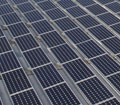One might think building-integrated photovoltaics (BIPV)—photovoltaic (PV) materials integrated into standard building materials used to assemble the building envelope—are a "no-brainer." They can reduce the costs, complexity, weight, labor requirements and amount of subcomponents associated with traditional PV installations. That has to be a good thing, doesn't it? Some folks in the traditional PV industry disagree because of one issue in particular—who will lose money from BIPV and who will gain it.
BIPV vs. BAPV
PV-enhanced building materials are considered BIPV when they directly are part of the building envelope materials and perform as well or better than their non-PV-enhanced counterparts. For example, the roofing industry considers adhered, flexible PV panels to be BIPV. However, if these criteria are not met, materials do not qualify as BIPV. Therefore, BIPV's definition excludes many PV industry players.
For example, let's say you install crystalline PV systems and typically use frames to support the systems on roofs. BIPV's definition would exclude your work because a supporting frame requires modifying the envelope with roof penetrations, increasing lightning protection and adhering extra weight to a roof. Therefore, rack-mounted PV materials often are called (somewhat tongue-in-cheek) building-applied photovoltaics (BAPV).
BAPV systems are pretty easy to spot. They include rack- or frame-mounted PV systems, including low-profile systems. These add weight and complexity and may reduce the function of standard building materials on which they are mounted.
There has been much interest from some crystalline PV panel manufacturers in producing directly adhered and frame-supported roof tiles. Some even have claimed their tiles can be walked on and tolerate the same use and abuse as standard roof membranes and tiles.
Additionally, there are systems that can completely replace rigid roof tiles while providing integral PV function. Some use a concrete-like supportive structure; others are being developed with supportive structures similar to standard roof tiles. Although as heavy as standard roof tiles, these meet BIPV criteria.
PV manufacturers that depend on glass for their PV substrates (not including PV manufacturers of glass-based systems used for windows, skylights, etc.) also could lose money; glass-based PV systems that require some type of roof frame for support are not BIPV systems. However, some glass-based PV manufacturers make BIPV and BAPV systems; in such cases, the manufacturer may benefit from the economic synergy of both system types.
Yet another group that stands to lose money in the BIPV market is power purchase agreement (PPA) financing companies that insist any system they finance be removable. This is supposed to deter nonpayment because the installed PV system, in theory, needs to be able to be repossessed. BIPV systems—because they are permanently adhered—are considered irremovable.
PPA companies that develop more practical business models that eliminate the "removable" parameter may profit from BIPV systems; those unable to do so could damage their bottom lines.
A good change
The roof is the most obvious place for BIPV advancement, but the PV industry often has ignored roof systems' longevity and durability and spent little time developing appropriate PV roof substrate installation procedures and material standards. Roofing professionals have said that not all roofs are appropriate for PV system installation, but there still are PV installers putting systems on roofs that will need to be replaced long before the PV products' service life ends. BIPV supporters must insist the roof system is as important as the PV.
BIPV products bring us much closer to the goal of reasonably priced, decentralized and distributed nonpolluting PV systems. They not only could help save our planet, they could help you save money. I consider that a win-win situation.
Dr. Kenneth Hackmeyer is chief energy scientist of ePGEN, a division of Derbigum Energy Sciences, Kansas City, Mo.



